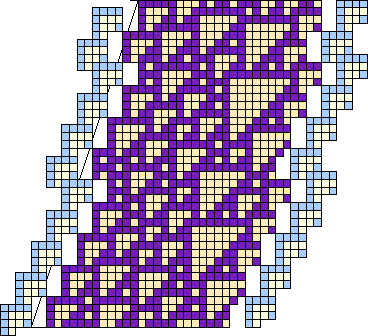 |
 |
The G family, on the other hand, fulfills its promise of involving the ``two right in five'' gliders. It differs from the E family in that the two superluminal traces comprising the extension alternate a two-high B strip inside the alpha with a three-high B strip in the same place.
These alphas are not such orphans as seemed at first sight, since they can merge with the ether, fuse style. Moreover, they just plain stop with the left-running slopes appropriate to the E's or B's, which means that their connection to the ether would also show up on the corresponding de Bruijn diagrams.
They also have fuse-like behavior on the left hand, and since the boundary slope is congruent, maybe an effort should be made to embed them totally into the ether. As it is, they need the large triangles in the slim E's or G's to anchor them. But since those large triangles are fairly common, one wonders whether they might extend other gliders. In fact, near the upper right hand corner of Cook's random sample is an episode which fits this description.
Extending the extension occurs when B gliders join up with the latent B's already present, and the process is totally additive, even for two B's right alongside each other. Apparently the effect of A's and B's, as dislocations, is to raise everything vertically by two cells. But that is just the rise needed to put new T5's in the superluminal stream. Since a superluminal stream is a phase effect, it isn't a real glider, and doesn't have to run on and on, as a true glider might.
Since the alphas run out from selected larger triangles, it is also possible to wonder whether there is a family present here, and whether it has any further members?
 |